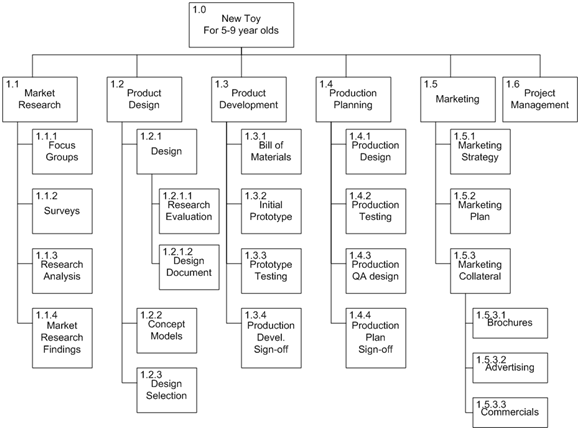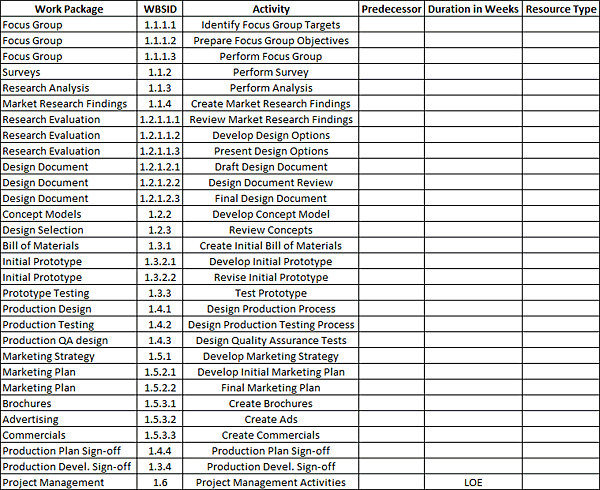Work Breakdown Structure (WBS) 2
Work Breakdown Structure (WBS)
https://www.projectinsight.net/project-management-basics/project-management-scheduleThe building blocks of a schedule start with a Work Breakdown Structure (WBS). The WBS is a hierarchical reflection of all the work in the project in terms of deliverables. In order to produce these deliverables, work must be performed.
A typical approach in developing a WBS is to start at the highest level, with the product of the project. For example, you are assigned as the project manager of a New Product Development project. The new product you are developing is a new toy for children age's five through nine. The objective of this product development project is to increase the revenue of the organization by ten percent.
Example of WBS:

Above is an example of a WBS for this new toy. Each level of the WBS is a level of detail created by decomposition. Decomposition is the process of breaking down the work into smaller, more manageable components. The elements at the lowest level of the WBS are called tasks. In the example above, brochures, advertising and commercials are all work packages or tasks.
Marketing collateral is on a summary level called a control account in project management parlance. In Project Insight, project management software, control accounts are called 'summary tasks.' Summary tasks are roll ups of the tasks underneath them.
The decomposition of a schedule will continue at varying rates. 'Brochures' is a task identified at the fourth level of decomposition, while the 'marketing plan' is also a task, but defined at the third level of decomposition.
As a project manager, the level of decomposition will be dependent on the extent to which you will need to manage. Project Insight supports as many levels of hierarchy as are needed. The expectation is that each task will have a single owner and the owner is expected to manage and report on the work necessary to deliver the task. In Project Insight, this is called the 'task owner.' If you cannot assign a single owner, or you need to have additional visibility into the progress of that task, additional decomposition is recommended.
Once all the deliverables of the project have been identified, tasks will be performed in order to create the deliverables. In some cases, these activities are the physical deliverables, but in other cases they are the actions that need to be performed. A physical deliverable, for example, might be an image (an actual file) that is needed for the brochure. Listing out each of the tasks to be performed will result in an activity list as demonstrated below.
Product Development Activity List

The work package 'focus group' actually consists of three (3) separate tasks—'identify focus group targets,' 'prepare focus group objectives' and 'perform focus group.' The work package 'surveys,' on the other hand, is not broken down into tasks. In our example, it may have been determined that the task owner that is performing the surveys does not need to report on any of the details of that task. As stated earlier, decomposition will continue to the level that is necessary to effectively manage the project.

Project Management
ReplyDeleteI am fully satisfied with the information you have posted. Good job. Keep posting
Building Information Modeling
Work Breakdown Structure (WBS) 2
ReplyDeleteTHANKS FOR SHARING SUCH A AMAZING WORK
NICE WORK
Project Management UK
ReplyDeleteIt was pretty Helpful, thanks for sharing..
mobile pampering service
mobile beauty service
Great post
ReplyDeleteThanks for sharing such a great post
Topxlisting
SSbizconsulting is an established firm of experienced and qualified consultants providing business & IT consulting services in Sydney, Australia. We provide project management services and IT consulting services to small and large companies across Sydney. To find out more about our services, please contact us.
ReplyDelete